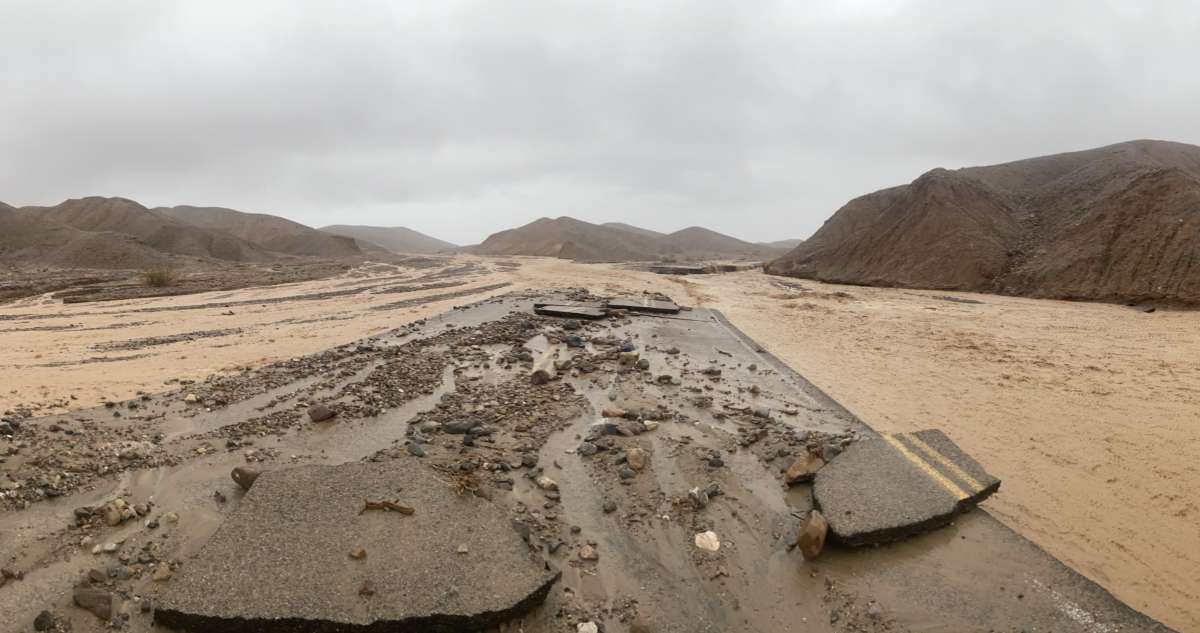Last week’s historic rainfall and flash flooding that caused widespread damage and left hundreds of staff and tourists stranded in Death Valley National Park is another clear sign of how extreme weather is being intensified by the fossil fuel-driven climate emergency, experts say.
The otherwise bone dry landscape between California and Nevada was pummeled by multiple downpours last week. Friday’s storm dumped an estimated 1.46 inches of rain at Furnace Creek — 75% of the annual average total for the park, where less than two inches of precipitation per year is typical — in just three hours.
The resulting torrent washed out roads, pushed dumpsters and other debris into parked cars, inundated hotel rooms and other infrastructure, and left extensive mud and gravel deposits, the National Park Service said. With Death Valley containing more than 1,000 miles of roadway and 3.4 million acres, officials expect a full assessment of the damage and ensuing repairs to take time. No injuries have been reported so far; aerial searches of remote areas of the park are ongoing.
Friday’s rainfall, which came after heavy rains last Monday led to flash floods and road closures in the area, fell just short of the all-time daily record of 1.47 inches, set in April 1988.
But it shattered previous August records and caused a deluge that Daniel Berc, a meteorologist with the National Weather Service in Las Vegas, described as a “1,000-year event,” which means that “there is a 0.1% chance of occurring in any given year.”
Major flash flooding in Death Valley National Park this morning. Approximately two dozen vehicles trapped in mud and rock debris at the Inn at Death Valley. Took nearly 6 hours to get out. #cawx #stormhour pic.twitter.com/3rDFUgY7ws
— John Sirlin (@SirlinJohn) August 5, 2022
“Events like this one, once thought to be exceedingly rare, are on the rise,” The Guardian reported Thursday. “Scientists are finding that weather extremes, fueled by the climate crisis, are becoming more likely in the American West, which continues to be mired in drought. Periods of dryness are expected to be broken with strong, destructive storms as the world continues to warm.”
“Described as ‘a land of extremes,’ the desert basin is the driest place in North America and is known for temperatures that have climbed higher than any other place on Earth,” the newspaper noted.
According to the National Weather Service, temperatures in Death Valley have been around 114°F this week and are forecast to reach 116°F on Thursday and Friday.
Last week’s “1,000-year flood is another example of this extreme environment,” said park superintendent Mike Reynolds. “With climate change models predicting more frequent and more intense storms, this is a place where you can see climate change in action.”
Death Valley is far from the only place that has recently endured extreme rainfall propelled by planet-heating greenhouse gas pollution.
This summer, floodwaters devastated Yellowstone and St. Louis and killed dozens of people in eastern Kentucky and Seoul, where mountaintop removal coal mining and semi-underground apartments, respectively, left impoverished residents more vulnerable to death and destruction.
“We are going to have to change the labeling because these are not one-in-1,000-years events anymore,” Andreas Prein, a climate expert at the National Center for Atmospheric Research, told The Guardian. “It’s shocking to see all of this flood damage but it follows a pattern. These rare events are becoming more and more common and our infrastructure is just not keeping up.”
“Climate change is increasing the intensity and frequency of flooding,” he added, “and it will likely get worse with further warming.”
Join us in defending the truth before it’s too late
The future of independent journalism is uncertain, and the consequences of losing it are too grave to ignore. To ensure Truthout remains safe, strong, and free, we need to raise $31,000 in the next 48 hours. Every dollar raised goes directly toward the costs of producing news you can trust.
Please give what you can — because by supporting us with a tax-deductible donation, you’re not just preserving a source of news, you’re helping to safeguard what’s left of our democracy.
